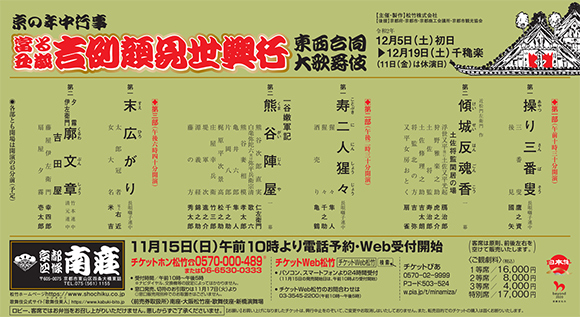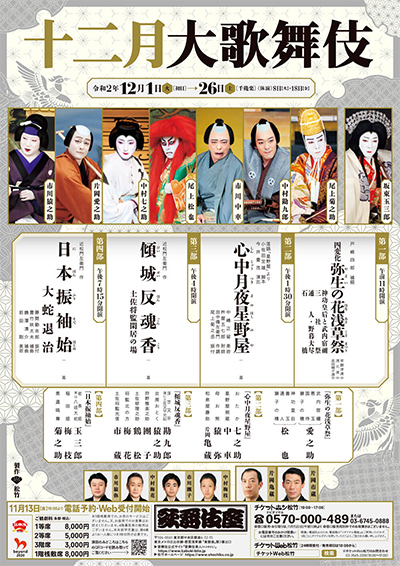| DECEMBER 2020 |
|
2 shows in Ky˘to (Minamiza) and 6 in T˘ky˘ (Kabukiza, National Theatre)!
|
|
|||
| Dates | 5 ~ 19 December 2020 Kichirei Kaomise K˘gy˘ Annual Festive Face-Showing Performances |
||
| 1st program |
Keisei Hangonk˘ (Domo Mata) |
||
| 2nd program | |||
| 3rd program |
Suehirogari |
||
| Casting |
Living National Treasure Kataoka Nizaemon, Living National Treasure Kataoka Hidetar˘, Nakamura Ganjir˘, Nakamura Senjaku, Matsumoto K˘shir˘, Nakamura Kinnosuke, Kataoka Takatar˘, Band˘ Takesabur˘, Nakamura Karoku, Nakamura Kazutar˘, Nakamura Kikaku, Kataoka Shinnosuke, Kamimura Kichiya, Kataoka Sennosuke, Nakamura Hayato, Nakamura Yonekichi, Onoe Ukon, Nakamura Toranosuke, Nakamura Takanosuke, Nakamura Jűjir˘, Kataoka Matsunosuke, Kamimura Kichitar˘, Sawamura Kuniya
|
||
| Comments |
The traditional kaomise in Ky˘to at the Minamiza. First Kabuki performances in Ky˘to since the beginning of the COVID-19 crisis. |
||
 |
| National Theatre (T˘ky˘) |
| Dates | 3 ~ 26 December 2020 |
| 1st Program | |
| 2nd Program |
Kumo ni Magou Ueno no Hatsuhana (K˘chiyama) Yuki no Shakky˘ |
| Casting |
Matsumoto Haku˘, Nakamura Shikan, Nakamura Tokiz˘, Nakamura Baigyoku, Nakamura Fukusuke, Band˘ Yajűr˘, Onoe Sh˘roku, ďtani Tomoemon, Ichikawa Komaz˘, Band˘ Kamez˘, Matsumoto Kingo, Nakamura Kangyoku, Ichikawa Somegor˘, Band˘ Shingo, Nakamura Matsue, Nakamura Mantar˘, Nakamura Fukunosuke, Nakamura Utanosuke, Band˘ Kamez˘ |
| Comments |
The December Grand Kabuki at the National Theatre in two programs:
|
| Kabukiza (T˘ky˘) |  |
| Dates | 1 ~ 26 December 2020 Jűnigatsu ďkabuki December Grand Kabuki |
| 1st program | |
| 2nd program | |
| 3rd program |
Keisei Hangonk˘ (Domo Mata) |
| 4th program |
Nihon Furisode Hajime (Orochi Taiji) |
| Casting |
Living National Treasure Band˘ Tamasabur˘, Onoe Kikunosuke, Nakamura Kankur˘, Nakamura Shichinosuke, Ichikawa Ennosuke, Kataoka Ainosuke, Ichikawa Chűsha, Kataoka Ichiz˘, Kataoka Kamez˘, Onoe Matsuya, Nakamura Baishi, Ichikawa En'ya, Nakamura Tsurumatsu, Ichikawa Danko, Nakamura Baika |
| Comments |
The December Grand Kabuki at the Kabukiza with 4 programs.
|
 |
|
|
| Contact | Main | Top | Updates | Actors | Plays | Playwrights | Programs | Links | FAQ | Glossary | Chronology | Illustrations | Prints | Characters | Derivatives | Theaters | Coming soon | News |